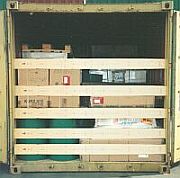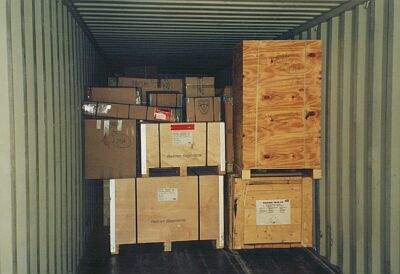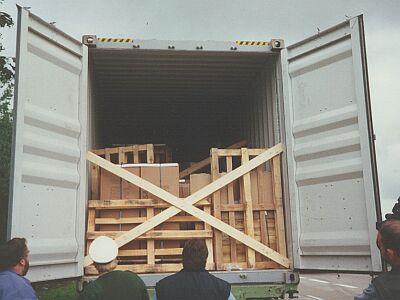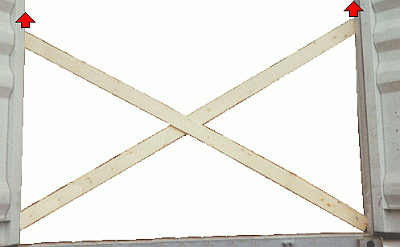 |
 |
|
| Lattice used to secure the face of a load | ||
Lattices can also made by nailing inexpensive, untrimmed wooden dunnage boards together. How lattices are to be placed in front of the load depends on the forces which have to be absorbed and what type of load it is. In the case of stacked, palletized goods which are firmly secured to the pallet, the variation shown on the right is suitable. Then, the horizontal boards in contact with the load should cover the lower area, the seams of the stack and the upper area. In the case of goods stacked in three layers, lattices must therefore be made of four horizontal boards.
 |
 |
|
| Bracing gaps in the door area of containers | ||
If the mass to be braced is not too large, the bracing can be placed directly against the lattice (left figure). If forces from larger masses are to be absorbed, an additional cross piece (1) must be fitted.
If pallets suitable for use with containers are available, for instance with the dimensions 1,150 mm x 1,550 mm or 750 mm x 1,150 mm, they can also be used instead of a lattice:
 |
|
| Bracing with pallets designed for container use | |
| Key: (1) Two pallets with the long edge placed transversely; (2) Squared lumber fitted in the corrugations; (3) Cross pieces fitted in the door area; (4) Squared lumber bracing; (5) Locking battens to prevent the diagonal stays from sliding together. |
If three pallets are arranged with the narrow edge running transversely, squared lumber can be inserted between the pallet boards.
 |
|
 |
|
| Securing by inserting squared lumber inside pallets |
|
| Key: (1) Three pallets arranged vertically - with the narrow edge positioned transversely; (2) Squared lumber inserted between the pallet boarding. |
If double deck pallets are not used, but four-way pallets are used instead, for instance, the completely boarded side should face the load:
 |
 |
|
| Four-way pallet | Arrangement of pallets |
Unsatisfactory packaging results in errors in load securing which could only have been prevented by additional outlay of material and work. The visible stowage gaps must be filled in any case:
 |
 |
|
| Stowage gaps between drums and other packages |
This picture clearly illustrates points where harmful load forces can arise.
The CTU guidelines require that when during the final stages of packing a CTU, care should be taken so far as is practicable, to build a secure face of the cargo. This is to prevent cargo from falling out when the doors are opened. A board fitted between the corrugations is not capable of ensuring this.
In order to come anywhere near fulfilling this requirement, it would have been necessary to have fitted a number of transverse boards or - better still - a lattice made of several boards:
 |
 |
It can be assumed that if the loads are otherwise correctly stowed, the boards or lattices will be held in place by the container doors, preventing any longitudinal shifting of the load. Since dynamic forces are no longer acting on the load when the container is opened, it is not to be expected that cargo items will be able to fall out when the doors are opened. In this way, the requirements of the CTU guidelines for a secure load face can be met.
A similar situation can be expected for the following container, although the securing forces of the diagonally fitted boards are not ideal:
 |
Securing the face of a load with diagonally fitted boards |
It is important that the boards are placed and nailed to each other in such a way that their position in relation to each other and to the container cannot change.
What is also unacceptable about this container is the quantity of old pallets which have been used and the carelessness of the packing.
The issues are completely different when gaps remain in the door area on partly loaded containers. Such primitive securing is in no way adequate here - whether boards or squared lumber are used:
 |
|
| Inadequately secured face of a load |
At (1), the squared lumber could slip down and then become loose. This "securing", already primitive enough, would then become ineffective. The usual error made in packing, namely leaving loading gaps, is also to be seen in this container (2).
Securing with squared lumber by bracing it against the corner posts of the container, is relatively quick and not excessively costly. Since the case (1) protrudes slightly out of the face of the load, no optimum solution is possible here.
 |
|
| Securing by bracing against the corner posts |
If the load is not braced against the corner posts, the wood fitted horizontally between the corrugations cannot hold the face of the load securely. This can result in damage to the container corrugations if the forces from the load become too high and the squared lumber is pressed toward the door. Fitting squared lumber and boards in the container corrugations is a very easy method of securing, but this method should be used on its own only for very light loads. In all other cases, boards and squared lumber must be fitted horizontally, supported against slipping down and also braced along the length of the container.
With the previous method, the transversely fitted squared lumber is subjected to bending stress across its whole width. The wood inserted at the container wall only has very little to "get its teeth into" on the corner posts. Securing material must therefore cover a large area and where possible be placed obliquely against the corner posts to ensure a high load-bearing capacity:
 |
Bracing against the corner posts with medium-heavy goods - Top view |
If the total weight of the load in the container is heavy or extremely heavy, additional squared lumber bracing against the doors must be provided.
| Bracing against the corner posts with heavy goods - Top view |
 |
 |
Bracing against the corner posts with very heavy goods - Top view |
 |
|
| Inadequately packed container section |
It is constantly forgotten that during transport, the vehicle is subject to changes in speed and direction. The inertia forces resulting from these changes set the load in motion relative to the vehicle.
Securing of the face of the load in the door area of this container is inadequate and needs to be improved in several ways:
 |
|
| Incorrectly loaded container with dangerous goods |
Dangerous cargoes were loaded in this container. But not - as the regulations demand - in the door area; instead they were "concealed" within the rest of the load. See Section 4.3.7 of the CTU guidelines for the relevant regulation. This states that "dangerous cargoes consignments which form only a part of the load of a CTU should, wherever possible, be packed adjacent to the doors with markings and labels visible."
Attention has already been drawn to the special measures required for securing cargo by the doors of a unit several times. It is dubious whether the two crossed boards can actually prevent the load from falling out if the container has traveled for some distance. This is partly because the boards were not beveled:
 |
|
| No beveling on the ends of the boards |
The fitted board does not have enough "to get its teeth into" in the groove of the container corrugations to withstand the potential loads.
 |
|
| Improved grip by beveling the ends of the board |
Beveled boards can withstand loads acting toward the door much better.
A weak point of all securing measures of this kind, however, is that the boards slip away toward the top and then no longer provide any protection.
 |
|
| Diagonally inserted boards can escape upward |
Theoretically, one viable solution to this would be to brace the boards toward the top, but it would be difficult or awkward to achieve this in practice.
 |
|
| It is not always possible to secure boards by nailing |
It is not always possible to secure diagonally inserted boards by nailing. This type of securing method should therefore be avoided entirely. Horizontally fitted boards or lattices are suitable for relatively light loads. Squared lumber or other lumber measuring 5 cm x 8 cm is a better solution for medium heavy goods. Professional bracing must be built for heavier loads.